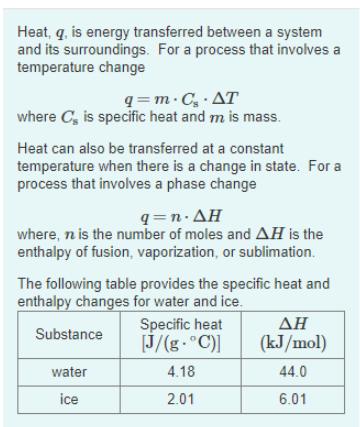Answered step by step
Verified Expert Solution
Question
1 Approved Answer
Heat, q, is energy transferred between a system and its surroundings. For a process that involves a temperature change q=m.C.AT where C, is specific



Heat, q, is energy transferred between a system and its surroundings. For a process that involves a temperature change q=m.C.AT where C, is specific heat and m is mass. Heat can also be transferred at a constant temperature when there is a change in state. For a process that involves a phase change q= n where, n is the number of moles and AH is the enthalpy of fusion, vaporization, or sublimation. The following table provides the specific heat and enthalpy changes for water and ice. Substance water ice Specific heat [J/(g. C)] 4.18 2.01 (kJ/mol) 44.0 6.01 Calculate the enthalpy change, AH, for the process in which 36.9 g of water is converted from liquid at 9.4 C to vapor at 25.0 C. For water, Hvap = 44.0 kJ/mol at 25.0 C and C = 4.18 J/(g. C) for HO(1). How many grams of ice at -18.1 C can be completely converted to liquid at 15.3 C if the available heat for this process is 5.7310 kJ ? For ice, use a specific heat of 2.01 J/(g. C) and AHfus = 6.01kJ/mol.
Step by Step Solution
★★★★★
3.57 Rating (164 Votes )
There are 3 Steps involved in it
Step: 1

Get Instant Access to Expert-Tailored Solutions
See step-by-step solutions with expert insights and AI powered tools for academic success
Step: 2

Step: 3

Ace Your Homework with AI
Get the answers you need in no time with our AI-driven, step-by-step assistance
Get Started


